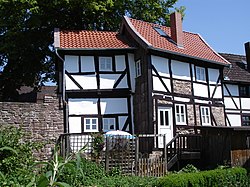|
Dassel
Dassel is a town in southern Lower Saxony, Germany, located in the district Northeim. It is located near the hills of the Solling mountains. GeographyThe city covers an area of 43.64 square miles (113.0 km2). Buildings and streets make up about 10% of this area while 26% are covered with forests like Ellensen Forest and 62% are in agricultural usage, especially for cereals and rapeseed cultivation. For this, the local soil horizon provides suitable conditions as sediments below the soil layer are made up of loess. Dassel is located in the temperate climate zone. HistoryDassel dates back to the year 860 when it was mentioned in a deed of the Imperial Abbey of Corvey. In 1022, Henry II, Holy Roman Emperor, in another deed referred to Dassel church. By about 1113, Dassel became a base of the counts of Dassel, whose name is derived from the name of the settlement. As the county of Dassel ceased to exist in 1310, Dassel was sold to Siegfried II, bishop of the diocese of Hildesheim. Shortly thereafter, in 1315, he provided his acquisition with town rights because the surrounding region belonged to the principality of Brunswick-Wolfenbüttel, thus to enemies of the bishop of Hildesheim. Once given town rights, inhabitants of Dassel built a defensive wall. Town administration operated from Hunnesrück Castle, on a nearby hill. That caste was occupied by the dukes of Brunswick-Wolfenbüttel as a result of the Hildesheim Diocesan Feud in 1521. Duke Eric I ordered to tear down Hunnesrück castle and had the Erichsburg castle built instead. Dassel was administrated from there until 1643. As a result of the Thirty Years' War, Dassel was merged with the diocese of Hildesheim in 1643. The bishops had new administration buildings built in a place called Hunnesrück, situated between the destroyed Hunnesrück castle and the Erichsburg. Throughout those centuries, these circumstances restrained Dassel from proper development and it was thus overcome by the neighboring city of Einbeck that was founded later than Dassel. In addition, parts of the city were destroyed in fires in the 19th century. In that time, some inhabitants started to weave linen or to trade with it, while others emigrated to USA. At the beginning of the 20th century Dassel had 1462 inhabitants.[3] Around 1920 the number of inhabitants amounted to 1601.[4] During World War II the town remained undamaged. Therefore, several expellees settled in Dassel. On March 1, 1974, Dassel was merged with several other small municipalities of the Ilme valley. The new borough now covers the area of the historic County of Dassel, which ceased to exist in 1310. On 15 April 2010 Dassel and its incorporated villages had 11434 inhabitants of whom 2597 lived in the historic town of Dassel itself. Main Sights
EducationThe Gymnasium (college preparatory school) in Dassel is named after Paul Gerhardt. The other general schools are two primary schools (elementary schools), and a secondary school (Realschule), which is named after Rainald von Dassel. Notable people
TransportationDassel was the endpoint of a private railway line from Einbeck since 1883. Its length amounted to 13.1 km. In 1975, the line was closed for passenger transport, and in 2003 for goods as well. Afterwards the railway line was replaced by a bus line. The former train station which was transformed into a residential building is well preserved. Dassel is easily accessible by bus from the neighbouring towns of Einbeck and Stadtoldendorf.
References
External linksWikimedia Commons has media related to Dassel.
|
||||||||||||||||||||||||||||||||||||||||||||||||||











![Medieval wall surrounding the old center.[7]](http://upload.wikimedia.org/wikipedia/commons/thumb/c/c1/An_der_Stadtmauer_Dassel.JPG/120px-An_der_Stadtmauer_Dassel.JPG)


